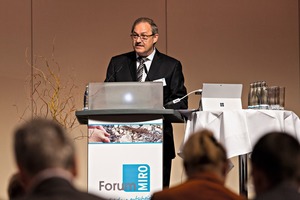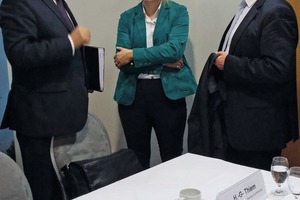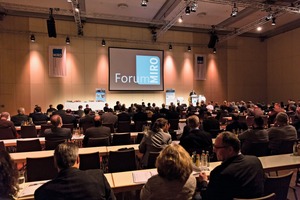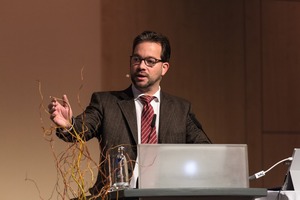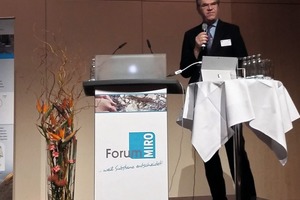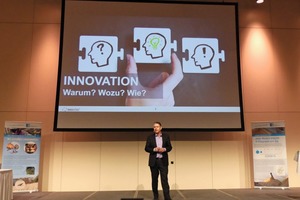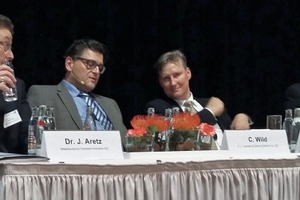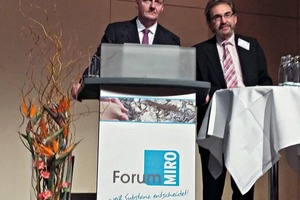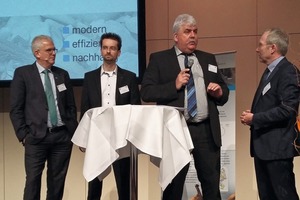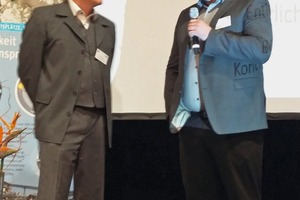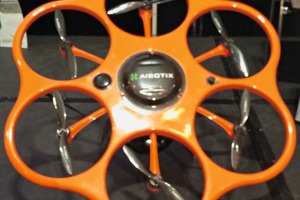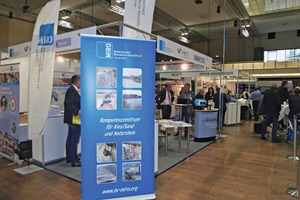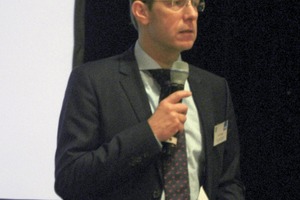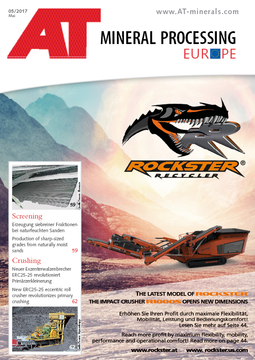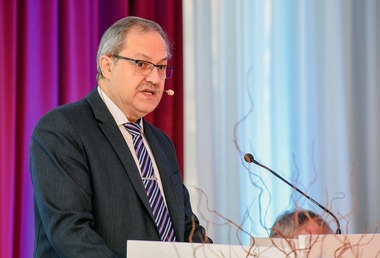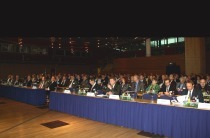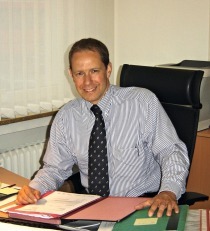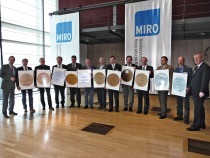Forum MIRO – Meeting of the German aggregates industry
At the 8th industry meeting of the German sand/gravel and natural stone industry, the flagship event of this branch of industry, Dr. Gerd Hagenhuth, President of Germany’s Federal Association of the Mineral Resources Industry (MIRO), welcomed 470 attendees in Berlin from 16 – 18 November 2016 (Fig. 1). An interesting programme with a plenary session on policy, legislation, technology, business administration, environment and communications as well as eight workshops accompanied by a trade fair with 75 exhibitors awaited the guests. As usual, before the beginning of the official event, the general meetings of the MIRO Federal Association and MIRO Research Association were held. On the first day, a press conference was arranged on the topic:
Mineral resources:
basis of our civilization and future (Fig. 2)
With a speech headlined “Data, energy, mobility – no network expansion without mineral resources” Gabriela Schulz, gsz Fachpressebüro Leipzig, opened this event, and her statement was underpinned by high-calibre representatives of the industry. Dr. Gerd Hagenhuth pointed out the “heavyweight importance” of his Association, after all the demand for relevant resources in Germany adds up to 500 mill. t/a – for construction materials through energy resources (quartz – photovoltaics) to cosmetics or pharmaceuticals. The industry engages in the optimized, sustainable extraction of resources. These are native resources, which are processed in sales- and demand-oriented, and accordingly CO2-minimized, low-cost production operations. “It cannot be that our domestic production and the value creation resulting from this is accused of not being careful in the use of resources. The opposite is the case!” said Dr. Hagenuth, concluding his remarks with a view to the difficulties with which the industry is faced coming from policy, authorities and the public. Support came from Dr. Harald Elsner, President of the Federal Institute for Geosciences and Natural Resources with his statement “Resources extraction in Germany – a closed book for the public”. He too emphasized that Germany is a key producer of raw materials for construction materials and, to a certain extent, of industrial minerals. Independence of imports, safeguarding jobs and the elimination of cross-border shipments are advantages that should not be underestimated. But despite extensive deposits, numerous restrictions exist associated with water, nature and landscape protection in accordance with German and European law, traffic routes and building developments block many deposits that would be worth developing. The Association has learned to live with that, criticizes, however, the dwindling acceptance of the extraction of mineral resources by the public in recent years, but also some NGOs, which needed to be countered urgently, for instance with information brochures. In this context, justified concerns of affected and worried citizens had to be taken seriously, but false ideologies disseminated among the public were inacceptable. Here, for example, policymakers were called upon to respond appropriately.
Finally, Hans-Georg Thiem, President of the Brandenburg State Office for Mining, Geology and Resources appealed for complex extraction management prior to each extraction operation. He pointed out the importance of a pre-emptive planning safeguards for the near-surface deposits worth extracting with reference to Brandenburg as an example. It should be noted that licensing procedures even for the extension of existing extraction sites are becoming increasingly difficult, protracted and expensive.
Plenary session
MIRO President Dr. Gerd Hagenhuth opened the session (Fig. 3), pointing out that this year especially a large number of students had been invited as they were guarantors of the industry’s future. He explained that Members of the Bundestag would also be invited to the next Forum in order to convey directly to them the advances in the industry, but also its needs and concerns. Besides technical competence, work safety was an important issue for the Association, the prevention strategy was paying off, as the drastic drop in industrial accidents showed. Here too, Dr. Hagenhuth emphasized the poor image that the industry suffered under owing to incorrect information and misrepresentation. His credo: “Germany’s aggregates industry doesn’t just talk, it acts – as the environmentally friendly supply of resources shows.”
Ulrich Meesmann, Employers Liability Insurance Association for the Raw Materials and Chemicals Industry, Heidelberg, described protecting the health of the employees as the priority task and presented the cooperation agreement between the Federal German Association of Mineral Resources and the corresponding associations in the German states. The aim is concerted implementation of the prevention strategy “Vision Zero”; the compiled measures also contained practically oriented measures for SMEs.
The welcome address of the Federal Ministry of the Environment was given by State Secretary Florian Pronhold (Fig. 4). This was preceded by an appeal by Dr. Hagenhuth to the State Secretary: “Please respect the fact that the industry produces the largest mass flow of resources in Germany and creates 25 000 secure jobs!”. He expressed the concern that the value creation could be relocated abroad. Florian Pronhold expressed his thanks for the good cooperation with the Association, which laid the foundation for Germany as an industry location and a place for people to live. He did, however, go into the conflict associated with the topic and the challenges that exist and which could not be resolved simply with a “not in my backyard” attitude. Desirable was, Pronhold continued, further intensive dialogue between the Ministry and Association and concerted reasonable approaches, for example, new ideas for compensation areas were required. Ideological trenches had to be removed. So, all peace and joy? Efforts were being made on both sides – this impression was conveyed at least by those who spoke.
EOD, Bau and RW –
consequences for the mineral resources industry
Dr. Harald Elsner, Federal Institute for Geosciences and Natural Resources – BGR, Hanover, (Fig. 5) presented the consequences for the mineral resources industry if ignorance exists and is indeed increased by misinterpretation. He explained that to combat this, the BGR was working with the State Geological Service to compile different brochures, for example “Industrial Minerals in Germany”, which present a positive image of the extraction of mineral resources. In this connection, Dr. Elsner criticized the negative representation of the topic by Germany’s Environment Agency UBA Dessau. In spring 2017, another brochure entitled “Mineral Resources” will be published.
Official address: innovation is possible
With his observations, Dr. Jens-Uwe Meyer, Innolytics GmbH, Leipzig (Fig. 6), leading innovation expert in Germany, showed how a very down-to-earth industry can reinvent itself. With reference to a number of examples, he demonstrated that innovation is urgently needed in the present time to be able to survive in business. The main problem was that the customers today no longer know what they want. “We do all want innovation, but no one wants to be the first (penguin principle)”. Yet: innovation can’t be stopped, today primarily innovation based on digitization, which is an innovation driver. Dr. Meyer is convinced: Digitization will not only change companies and markets, but redefine them from the bottom up. In his very passionate and impressive talk, the speaker gave several tips for innovative procedures, for example radical efficiency improvement with fully interconnected processes or competence digitization (Example: geblitzt.de). He stressed that it was important, however, to find a balance between renewing and preserving. Apart from that, he continued, it wasn’t necessarily about inventing new things, but engaging with new things and allowing failure (remembering Edison who undertook 10 000 experiments of which only four worked).
MIRO work safety competition
MIRO compiles accident statistics annually. It combines this with a work safety competition and honours the award winners at the opening ceremony of the MIRO Forum, as in this year too. A total of 12 companies were honoured with certificates in gold, silver and bronze. For example, in the section for natural materials companies, Kalksteinwerk Neandertal GmbH, Laubach and in the section for sand and gravel, the Mühlberg plant owned by Elbekies GmbH in Eurovia Gestein GmbH were awarded the coveted certificate in gold for an outstanding safety record. Moreover, member companies that could document zero accidents over three, five or seven years were honoured.
Workshops
The afternoon of the first day of the conference was reserved for the following workshops, which within the bounds of this report can only be covered globally apart from selected exceptions.
Current cases from law and the courts
A sense of proportion and scope for discretion in licensing procedures are required in many cases by companies to allow them to engage in business activity within a reasonable time period. Of great interest here were certainly the remarks on recent court verdicts, for example of the Münster’s Higher Administrative Court (OVG Münster) on the water protection area (Dr. Kay Artur Pape, Redeker Sellner Dahs, Bonn) or the impact on the verdict on deepening of the River Weser on the mineral resources industry (Prof. Dr. Bernd Dammert, RA Dr. Dammert & Steinforth, Leipzig).
Technology – innovative
With three excellent papers presented by competent speakers (Fig. 7), the focus on technical aspects was increased in the programme of the MIRO Forum 2016. Working on the back of many calculations and tests, Christian Wild, F.L. Juchem & Söhne GmbH & Co. KG, Niederwörresbach gave practical tips on what the “right” excavator/wheel loader shovel should look like. Even when working with an abrasive material like quartz, a bucket optimally adapted to the digging arc can handle 400 000 t in five years without needing any major regeneration work. The penetration resistance as well as the shape and gap of the bucket have been optimized and scrapers attached to the sides of the bucket, to mention just a few results.
In his talk “Know – don’t guess: from gut feeling to reliable figures”, Bernhard W. Tabert, Zeppelin Baumaschinen GmbH, Garching summed up: “Only what I can measure, I can manage!”. Based on recording of idle running times and their IT evaluation, he showed how company managers can be given a tool to better manage work in the quarry. Or to put it in more general terms: you must analyse internal operating procedures and manage these to save on operating costs. Finally, Dr. Dirk Blume, TEAM Technology, Engineering and Marketing GmbH, Herten, showed that energy and process monitoring represents a closed solution for extraction and processing.
Latest antitrust developments in the mineral resources industry
The detection of illicit supply consortia based on sector analyses, following the asphalt and concrete industries, is regarded as very probable in the aggregate industry. Because of this procedure, the joint sales opportunities of SMEs are severely restricted, while widely networked group structures are favoured. The sector surveys conducted by Germany’s Federal Cartel Office were only one aspect of the interesting talk presented by Dr. Jürgen Beninca, Morgan, Lewis & Bockius LLP, Frankfurt, who showed that competition law is much more than simply a ban on price agreements (Fig. 8).
New ways with and to good employees
In this session of talks, interested attendees obtained useful information, e.g. about “The training landscape in the natural stone and aggregates industry” (Prof. Dr. Albert Daniels, Georg Agricola University of Technology, Bochum) or “How do you coach operations managers?” (Sabine Gilliar, Gilliar Consulting, Darmstadt).
Compensation areas – where to get them if not steal them
Providing compensation areas is normality for extraction operations. Unfortunately, it is becoming more and more difficult to find these. With unusual ideas, however, it is possible to obtain a compensation that the authorities recognize. This was shown by Prof. Dr. Martin Kirschbaum, KiProCon GmbH & CO. KG, Korbussen, with his status report “Competition of mineral resources extraction with other uses”. The speaker began by giving an overview of the land use in the Federal Republic of Germany: 53 % agriculture, 30 % forestry, around 17 % other uses (0.0076 % land use for raw materials, of which 0.0042 % mineral resources, for comparison: 4.1 % nature conservation areas). The competing use claims by forestry and agriculture, energy generation and distribution, residential, commercial and industrial construction, etc. cause restrictions in respect of deposit reserves. Other consequences are restrictions in operations (emission quotas), with regard to cost efficiency (high costs incurred for additional measures and higher planning costs) regulations or other claims for compensation based on remuneration or compensation areas. In addition, they require a comprehensive monitoring of related aspects, risk analysis and estimation of the impact on the level of company management, intelligent and professional management of conflicting goals and often compromise and compensation solutions. His conclusion: The competing uses can have considerable impact on both the existing and planned raw materials sites. Company owners, operators and planners of mineral resources sites, even those in possession of long-standing permits, are urgently recommended to identify potential structural changes at an early stage, include these in their planning and make appropriate provisions.
Daniel Schulte, L.A.U.B. Ingenieurgesellschaft mbH Kaiserslautern spoke about a vision: “Foundation – long live the wonderland in the mineral resources”. It is clear that any intervention in nature triggers compensation obligations, usually requiring external areas, and interests concerning legislation on species protection have to be taken into account and much more, which often leaves company owners to make difficult decisions. One possible solution approach is seen by the speaker in the creation of an ecoaccount in the form of a foundation with extensive green spaces and tree and shrub planting. The advantages and disadvantages of the foundation model were described. A successful practical example – Mehlinger Heath at Kaiserslautern, a foundation of the German government, the state of Rhineland-Palatinate and Kaiserslautern district – was explained. Purpose of the foundation is to finance the measures needed to preserve the heath biotope from the foundation capital. The heath area was developed after use as a military training ground. A similar concept was proposed by Thomas Beisswenger, Association of the Non-Metallic Minerals Industry in Baden-Württemberg, Ostfildern, who appealed for the creation of a Land Management Agency. He called for the realization of compensation areas over the entire country and the incorporation of the extraction of mineral resources in biotope development (Fig. 9).
Public relations – practical and targeted
There is certainly no patent remedy for PR work in the sensitive area of mineral resources extraction. Prof. Dr. Dr. Olaf Kühne, Eberhard Karls University of Tübingen, showed, however, how it was still possible to pursue successful PR and presented the first results of the MIRO research project “Mineral resources industry & public perception”. Raimo Benger, Association of the Construction and Raw Materials Industry, Duisburg, presented a successful case study from the field in North Rhine Westphalia (“Dialogue creates a future”).
Practised sustainability
Sustainability according to the three-pillar model (environmental, economic and social sustainability) is part of day-to-day practice in the industry today. Testimony to this is not only the awarding of the German Sustainability Prize by the Association, about which Dr. Olaf Enger BV MIRO, Cologne, reported. In addition, two other talks were devoted to biodiversity (Gerhard Eppler, NABU Hessen, Heppenheim, and Birgit Michel, HeidelbergCement AG, Heidelberg).
Quarry and gravel works 4.0
Industry 4.0 – the fourth major industrial revolution has, of course, also made inroads in the sand, gravel and natural stone industry – the participants at this workshop were able to convince themselves of that. Benjamin Busse, IngenieurTeam GEO GmbH, Karlsruhe, (Fig. 10) impressed with innovative possibilities using drones in a gravel works. These drones (Fig. 11) can used for orthophotography from a height of 100 m to show a wide range of objects in a grid. The UAVs (unmanned aerial vehicles) are seen as a complement to classical methods. The advantages include an extremely high point density, and the fact that a survey crew is not required. Typical applications are the generation of 3D models based on aerial inspection (structures) or on thermography (solar, photovoltaic systems) or collection of evidence based on image documentation of large areas. To close, the speaker described the legal situation concerning the use of drones.
Dr. Marc Dohmen, DOHMEN, HERZOG &Partner GmbH, Aachen, spoke on the topic “Big data in the quarry – from drilling through licensing to diesel consumption” and showed that extensive digitization and interlinking of data is the precondition for Industry 4.0 in practice. In concrete terms, it is a matter of realizing the following main points:
Digital logging of data and deployment of dedicated hardware
Logical interlinking of data
Visualization, monitoring and evaluation
Implementation of decision processes.
The speaker explained that digitization was already underway in many operations, but it was not enough just to enter data in Excel spreadsheets, instead it was necessary to make the data available in well-structured form in databases. Practical examples and developments expected for the future supplemented the informative talks. The conclusion of Uwe Wirth, Praxis EDV-Betriebswirtschaft- und Software Entwicklung AG, Pferdingsleben (“Interlinking of production, finishing and construction site”) was clear: Industry 4.0 offers the possibility for great cost savings, which he explained with reference to the example of electronic delivery note logging and evaluation.
An interesting and lively discussion followed, which went as far as Industry 5.0 with neuronal networks and artificial intelligence. But first it was necessary to sift through and process the flood of data that companies will be confronted with on the advent of Industry 4.0.
Trade exhibition –
hands-on opportunity to see innovations
The extensive supporting trade exhibition (Fig. 12) offered the attendees another opportunity to gather information, take a close look at new products on the market and to discuss aspects with the extraction, conveying and processing equipment exhibitors. Represented in Berlin were renowned companies such as Atlas Copco Berg- und Tunnelbautechnik GmbH, Essen; Siebtechnik GmbH, Mülheim/Ruhr; thyssenkrupp Industrial Solution, Essen or Habermann Mineral Systems GmbH, Witten. But smaller companies, associations, publishing houses and consulting companies were also on hand to provide the visitors with the information they wanted.
Summary
Following two work-filled days, Dr. Olaf Enger, General Secretary at MIRO (Fig. 13) gave a positive review of the overall event including the general meetings, forum, exhibition. Besides the stronger focus on technology this year, legal aspects were discussed that are impacting the industry more severely and must be taken into consideration. In all eight sessions of the workshops, current problems were discussed and interesting solution approaches presented, which can serve as recommendations for the industry to take action or at least as impulses for further work. Dr. Enger referred to communication as a core issue, and this was a feature of many of the talks, being addressed from a wide range of perspectives, be it for recruiting new employees, to communicating a company’s own achievements and the necessity to draw attention to the industry as a whole so as to show that many crucial products are produced and that new installations and plant extensions are being built. All that has to be communicated through a wide range of channels, both classically based on print media, and with modern communication media. And that has to happen on all levels, starting with the companies themselves through associations on German state level to Germany’s Federal Association. Breaks and a splendid evening event held at the “Altes Wasserwerk”, Berlin’s old waterworks now converted to a club venue, provided ample opportunity for the attendees to talk and get to know each other.
The next Forum MIRO takes place in turns of two years – that is in 2018.
Autor/Author: Dr. Brigitte Hoffmann, Consulting
Kreislaufwirtschaft/Umweltschutz; Oberschöna/Deutschland

